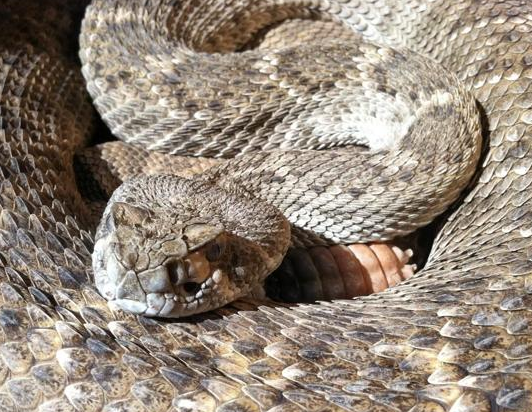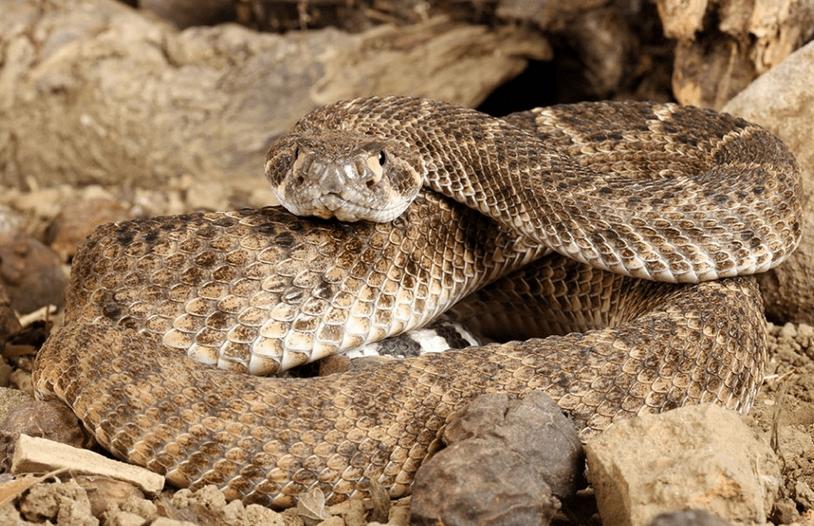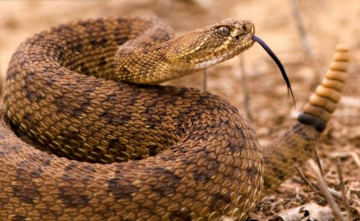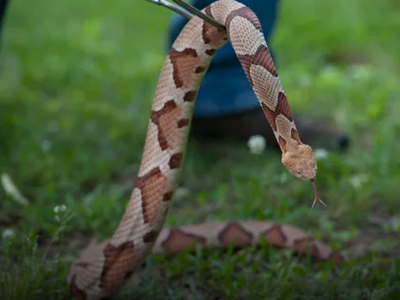Friday, September 11 2020
North America is home to dozens of venomous snakes, everything from the small and elusive coral snake in the southern portion of the country, to the much larger timber and diamondback rattlesnakes. But that doesn’t mean you should avoid hunting in snake country. Some of the best hunting grounds for deer, elk, bear, turkey, wild boar, pronghorn, big horn sheep, moose, and other game takes place in areas where poisonous snakes are not just present, but common. If you’ve hunted for any length of time, you’ve no doubt at least seen a snake or two from a distance. Thankfully snake bites are not something that occus every day, but a bite from a venomous species can cause extensive damage and, in some cases, even death. Knowing how to avoid and treat a venomous snake bite is a crucial skill for any hunter. treat a venomous snake bite is a crucial skill for any hunter.
Know Something About Snake Habitat and Habits So You Can Avoid Them
A critical first step toward staying safe in areas where poisonous snakes are found is to have a basic understanding of snake ecology. As exothermic animals, snakes must regulate their own body temperature. If it’s cool they will likely seek out a place where the sun’s rays will warm their bodies—on roads, rocks, stone paths, etc. In hot weather, snakes will find spots that are cooler, such as under a fallen log or in a rock pile. Avoid common snake hideouts like deadfalls, tall grass and brush, and rock slides. When you are in the woods, be sure to step on and then over fallen logs and large rocks, and never reach into areas that don’t offer enough visibility to see a snake. The key is to train yourself to recognize potential snake hazards and to avoid them. Most snake bites occur on the hands, lower legs, and feet when someone inadvertently gets too close to an unseen snake. Watch where you sit. It’s true that snakes are most active in the early mornings during the summer months, but snake bites can happen year-round. Stretches of warm weather at any point during the year bring these reptiles out of hiding. Chilly weather often makes snakes more lethargic, but they could be on the move because they are seeking shelter from an imminent cold front. A lesser known fact is that rattlesnakes can only bite from a coiled position. And not all rattlesnakes actually rattle a warning before striking.
Don’t Antagonize Snakes
This should be common sense, but a number of snake bites each year occur because people intentionally put themselves in a position to be bitten. Emergency room doctors report that the most common snake bite victim is male, between the ages of 18 and 35, and the most common place they are bitten is the area between the thumb and forefinger. Usually, there is alcohol involved. Obviously you won’t be drinking if you are hunting, but you get the idea. It’s not a good idea to try and kill a snake you see in the distance. It’s not a good trophy. Snakes are fascinating creatures and you might want to get a closer look out of curiosity, but they deserve a wide berth. When you spot a snake – stop and take a few steps back.
Have the Right Equipment
The most obvious piece of gear you’ll need for hunting in snake country is a pair of snake-proof gaiters or snake-proof boots. In rocky terrain it’s a good idea to have a shooting stick to help you navigate through rough terrain. Sticks accomplish two things. First, they help keep you from falling down into a rock slide or brush pile that may contain a snake, and second, they allow you to stabilize yourself without exposing your hands or legs. Carry a good flashlight in snake country. Communication is key, so if you don’t have a cell phone that works, carry a radio or satellite phone—something that allows you to call for help if you are bitten (or for any other emergency).
Know What to Do if You’re Bitten by a Snake
Avoiding snakes is the best option, but if you are bitten you need to know how to react. The first step is to get away from the snake, making sure that you and others are out of harm’s way. If you can identify the species that may help, but don’t put yourself at additional risk to try and see or catch the snake. There are several myths about sucking venom from the wound, but that’s only Hollywood. Don’t “cut and suck” like in the movies! Prompt medical care is the only reliable option. Increased blood flow spreads venom more quickly, so the first step is to remain calm. Exert as little effort as possible to minimize heart rate and the spread of toxins within your body. Try to keep the bite site below the heart if possible and control breathing. Remove any jewelry like watches or rings because there will be swelling. Cover the bite with something clean, like gauze but don’t put too much pressure on the wound. Every snake bite should be treated as an envenomation (as opposed to a dry bite when the snake strikes but does not inject venom). Get to a doctor as quickly as possible!
Although it’s true that one errant step in snake country can turn a wilderness hunt into a life-threatening emergency, keep in mind that snakes are generally not aggressive unless threatened (by accidentally stepping on or near them) or if deliberately provoked. Given room, they will retreat. If you plan to be trekking through prime snake habitat this hunting season, use these tips to stay safer.
Saturday, June 20 2020
It’s summertime, and like it or not, snakes are out. Last year, several news organizations reported an increase in the number of venomous snake bites in Texas, North Carolina, Georgia, California, and Arizona. Rapid urbanization and higher-than-normal amounts of rain were blamed for the spike in bites, especially since they were occurring more frequently in suburban areas. People can encounter snakes while walking trails, camping or just doing summer yard work. In fact, recent encounters with snakes hiding under car hoods and in pool noodles have made the news. So even if you are sheltering in p lace due to COVID-19 and not out recreating much, you may still encounter snakes in and around your own home. lace due to COVID-19 and not out recreating much, you may still encounter snakes in and around your own home.
Did you know that there are over 3,000 species of snakes on Earth? While not all of them are perilous, per se, certain slithering serpents are extremely dangerous. Common venomous snakes include western diamond-backed rattlesnakes, copperheads and the cottonmouth, also known as the water moccasin. The range of species and likelihood of an encounter differ from region to region and specific locations. For instance, it’s much more likely to see a cottonmouth around bodies of water, like ponds, lakes or creeks, as well as bottomlands that maintain high levels of moisture throughout the seasons. Although it is best to always avoid contact with all snakes, the Western Diamondback Rattlesnake is probably the most feared. Rattlesnakes are unique to the Americas, with at least 32 recognized species living in a multitude of habitats. Though they are icons of the Southwest, rattlers are found in many states across the country. Part of what makes the Diamondback so deadly is its refusal to back down when partaking in a stand-off. While many snakes are venomous but calm, this desert-dwelling critter can be super aggressive when provoked! This viper coils and rattles its tail (you’ve heard the sound) to warn enemies to stay back. When said enemies don’t take the warning seriously, the sassy snake will strike, and its venom packs quite the punch.
Because snakes are cold-blooded, they prefer sun and/or stretching out on warm surfaces like rocks, pavement and other heat-absorbing materials when temperatures are cooler. Just like people! But in the heat of the summer, they prefer shade, especially from the midday sun. “Contrary to popular belief,” explains a professor of biological sciences at California Polytechnic State University, “rattlers don’t like to be out when it’s really hot. When the temperatures hit triple digits and the monsoon comes, people aren’t the only ones seeking relief. Snakes will hide under something on the ground in people’s yards to get away from that extreme heat.”
What a lot of people don’t know is that venomous snakes typically do not want to use their venom as a defense. They usually give warnings – like rattlesnakes rattling – before they strike. The Texas Department of Health Services reported that half the reported bites by venomous snakes were “dry,” meaning no venom was injected into the victim. Of course victims don’t know that at the time so always seek immediate medical help. A snake strikes because it views you as a threat. Producing venom is an energetically costly process, and they only have so much. If they use it, they must make more to hunt for food, and they have to work for every single meal, so striking to defend themselves is something they would rather avoid.
You can’t get rid of snakes, nor should you necessarily want to. Rattlesnakes can actually do a service to homeowners near the foundation by eating rodents. Learn how to live with them so you, your kids, your pets and the snakes can all be safe. They are integral to ecosystems because they eat insects and rodents you don’t want around the house, in your garage, our outbuildings. Just leave the animal alone if you see one. The Phoenix Herpetological Sanctuary says an estimated 80 to 90 percent of rattlesnake bites occur when untrained people try to move or harm the snake. It’s best to give them plenty of room and let them go on their way. There are no chemical repellants proven to deter snakes, so removing potential shelter and food sources is the best way to NOT attract snakes. Cutting the grass, removing brush and debris, and trimming the lower branches on bushes and trees will go a long way in reducing the places a snake might want to hide. Reducing hiding spots for snakes will also reduce hiding spots for the prey they seek, like rats and mice.
The best advice this summer is as lockdowns are lifted and people get out and about is to be alert and check your surroundings. Wear appropriate protection such as snake gaiters, snake proof boots, or snake chaps, and never purposely disturb or touch a snake.
In the event you are bitten by a snake:
- Remain calm, and move away from the snake.
- Immediately call 9-1-1 or send someone for help and safely transport the snake bite victim to the nearest emergency medical facility for treatment.
- Remove wristwatches, rings or anything constrictive.
- Gently wash the area with soap and water. Keep the bite at or below heart level.
- Try to remember what the snake looked like so you can tell the emergency room doctor (but do not attempt to kill or catch it!)
- Do not cut open the wound and try to suck out the venom. Do not use a tourniquet - this will restrict or cut off blood flow and the limb may be lost.
Monday, March 16 2020
Snakes love warmer days. As reptiles, their body temperature mirrors air temperature, so it’s common to begin seeing many more snakes already this year. In fact, the Scottsdale Fire Department was dispatched to a hiking trail last week to remove a 77-year-old male male suffering from a rattlesnake bite. He was transported to the hospital. Also recently, a Phoenix man was bitten by a rattlesnake while out riding his bike. He pedaled himself to the nearest emergency room and received treatment. Most Arizona emergency departments and hospitals have anti-venom. But there's only a couple of hospitals that have medical toxicologists that specialize in this care. A hospital in the Phoenix area with a toxicology referral center sees 50-75 rattlesnake bite patients annually. Of those, 5-10 people die from the bites. Anyone who gets bit by a rattlesnake should get anti-venom as soon as possible. Wherever the bite is, is where most of the damage is going to occur. And that means breakdown of muscle and skin, as well as a lot of edema and swelling. Each person’s experience will depend on how much venom is injected.
Regardless of the state in which you live, if you work, hike, fish, hunt, prospect for gold, metal detect, ride ATVs, etc. in rattlesnake country, and there is decent numbers, you’re likely going to encounter some snakes this year. Keep in mind that snakes of many species are through hunkering down now that the weather is warmer, making human encounters more likely with ALL types of snakes. You might even see snakes in more northern areas where you’ve not seen them before. “It may have something to do with climate change,” says a wildlife ecologist. “There has been a lot of range expansions of a lot of animals and plants with climate change, and if that continues, they may end up moving north.” For example, Timber rattlesnakes have been found as far north as Red Wing, Minnesota. They find shade under logs and other hidden enclosures during hotter periods of the year.
If you’re wondering how to deal with snakes you might find in your own backyard, keep in mind that nonpoisonous snakes are harmless. They eat mice, rats, and other pesky rodents you don’t want around. Having them near the house is a good thing. When disturbed, these harmless snakes usually just slither away. They prefer to avoid contact with humans. Because you never know what type of snake you might encounter, wear gloves when weeding ground cover around the house. Wear snake gaiters or snake boots when hiking or working around timber.
To avoid accidental encounters with snakes, watch where you place your hands and feet when roaming fields and woodlands, especially in rocky areas. Poisonous pit vipers such as copperheads and rattlesnakes have triangular heads, vertical pupils, and prominent heat-sensing pits between the eyes and nostrils. These characteristics can be difficult to see from a distance, but don’t take a chance — keep your distance. If the snake is within five to six feet of you, make slow movements and move in the opposite direction of the snake. Though copperheads are more common and widespread than rattlesnakes, their bite is much less dangerous. That’s because copperheads are smaller, they deliver less venom, and their venom is weaker than rattlesnake venom. Generally, rattlesnakes are considered the most venomous and the most likely to cause death. Treat any snake bite seriously whether you know for sure what bit you or not! Two (sometimes just one) puncture wounds identify a venomous snake bite. Keep calm and get to the nearest hospital as quickly as possible.
In the warm deserts, rattlesnakes are most active from March through October. In the spring, they are active during daylight hours. As days become increasingly hot around early May, rattlesnakes become more active at night and spend the day in a spot of shade or a cool shelter. Don’t take a chance! Be vigilant and take precautions such as wearing snake bite protection in the form of snake gaiters or snake boots to be safe in snake country— whether that be in the desert or the woods.
Monday, February 10 2020
Encountering an aggressive copperhead snake in January is pretty rare in most areas, but getting bit by a copperhead that was hiding in a tree is unheard of! Or so folks in Mississippi might think… until this recently happened to a hunter. It's the stuff of nightmares!
Last month, Mr. Hardy was taking the last of his dog pack back to his truck one evening when he encountered a flooded ditch. He found a narrow spot where he could jump across. When he leaned forward to jump, he felt a severe pain on th e left side of his head. At that moment, he had no idea what had hit him, until he shined his light on a branch near his head and saw something he never expected— a snake coiled up on a tree limb about six feet off the ground. Startled by the flashlight, the snake struck at the hunter again and fell out of the tree. e left side of his head. At that moment, he had no idea what had hit him, until he shined his light on a branch near his head and saw something he never expected— a snake coiled up on a tree limb about six feet off the ground. Startled by the flashlight, the snake struck at the hunter again and fell out of the tree.
Mr. Hardy was hunting with a friend and both identified the snake as a copperhead, which is common in Mississippi and venomous. Both hunters grabbed the dog and loaded her and their gear in the truck. Even though that took only a couple of minutes, Hardy was already feeling the effects of the bite. "It was a lot of severe burning. By the time I got in the truck the burning was spreading. It started spreading rapidly, the swelling,” he said. Amazingly, the two hunters didn't panic. They called the closest hospital so that the emergency medical team would be prepared when he arrived. Five vials of Crofab, an antivenom, was administered at that local hospital, and then Mr. Hardy was airlifted to a medical center in Jackson. After a day of hospital care, doctors agreed to release him because his wife is a nurse practitioner and could monitor his condition at home.
“Copperheads are basically terrestrial snakes, but it's been known that they will climb trees,” commented a local herpetologist. “One of the more common times for copperheads to climb is during summers when cicadas emerge from the ground and cling to trees and bushes while they shed their shells. During that time, copperheads will climb to eat the insects.” Since the hunter was bitten in January, that obviously wasn't the case here. One theory is that this particular copperhead ended up in the tree because it was caught in flash-flooding that occurred the day before. "I'll be looking [for snakes] the rest of my life," Hardy said. "I'll get some snake boots and a hat, I reckon."
If that scary incident wasn’t enough, a couple of weeks prior to that, another hunter, Mr. Ginn from Lexington, was trapped in a small hunting blind with a rattlesnake. It was a warm morning with temperatures in the 60s, so seeing a snake wasn’t too surprising, but hearing a rattling sound and then discovering a rattler next to his boot in a four foot by four foot space with no way to escape was more than alarming! With the commotion of the hunter jumping on his chair, the snake became more agitated and was striking at the chair each time it moved. Ginn took aim through his scope at the snake's head, fired, and missed. Scopes are great tools for shooting at long distances, but at a couple of feet, not so much. The hunter then put the barrel close to the snake's head as the snake was striking at it and fired. The rattling stopped, the snake was dead, but Ginn’s ears rang all day from firing a high-powered rifle in a metal building no larger than a typical public restroom stall "I shot twice. There's no telling what it would have measured on a decibel meter.” The snake measured about four and a half feet, had eight rattles, and its girth was larger than a canned drink.
Copperheads and rattlesnake are only two types of venomous snakes found in Mississippi. The cottonmouth is another. A local snake expert said Mississippians should not be surprised to see snakes at any time of year in the South. They don't truly hibernate. Snakes do something called brumate, at which time they're semi-active. They move around a little. Because of that, and combined with Mississippi's mild winters, you can find snakes in Mississippi twelve months of the year. Obviously these unfortunate snake encounters are not the norm, and should not keep people out of the woods. But keep in mind that in the South, snakes are active year-round, so protect yourself as best as you can by being very aware of your surroundings and wearing snake gaiters or snake proof boots.
|